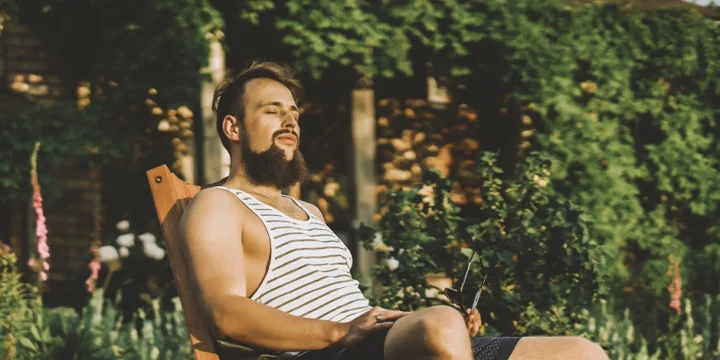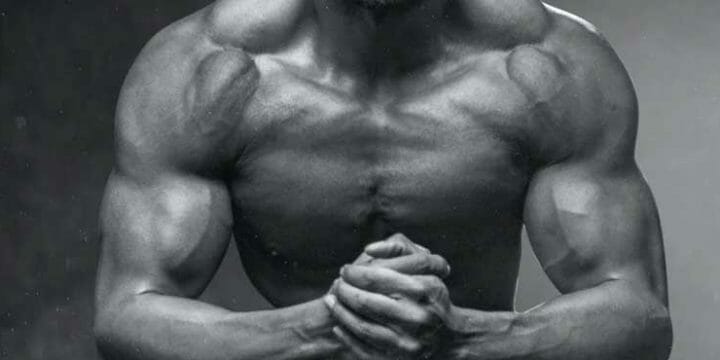Whether you’re lifting as an amateur or for competitive sports, compound exercises (like the squat, bench press, and deadlift) are crucial for enhancing muscle mass and athletic performance.
In my 10+ years of training clients, I’ve always incorporated squats in their training, and some of them asked me if this particular exercise can help boost their T-levels.
I decided to read up on what the scientific literature said about this, so I spent a few weeks researching various studies and discussing them with my colleagues to understand more about the hormonal effects of squats.
Quick Summary
- Squats can increase testosterone levels when done properly, and effectively.
- The benefits of doing squats range from hormonal balance to building stronger lower muscles, reducing the risks of developing an injury and enhancing athletic performance.
- According to Harvard Medical School, a 155-pound person could burn 223 calories in 30 minutes of squat training.
- In my professional view, squats are an unparalleled exercise for boosting testosterone and overall fitness.
Do Squats Increase Testosterone Levels?
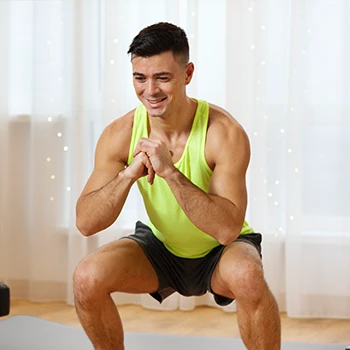
Benefits of Doing Squats
Now that it’s clear that squats increase your testosterone levels, let’s take a look at some of the many benefits this exercise offers.
1. Hormonal Benefits
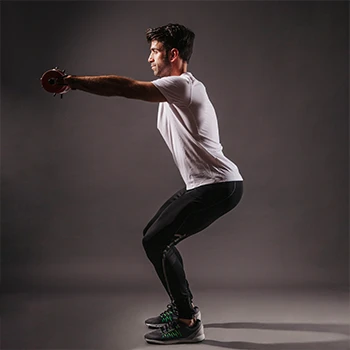
When training folks with low testosterone, I find squats help them bulk up faster than other compound exercises if they eat right and recover properly.
Squats likely boost human growth hormone (HGH), key for cell growth. Harvard Medical School says HGH peaks in puberty and dips after middle age [4].
The American Diabetes Association recognizes the importance of human growth hormone (HGH) for muscle building and protein synthesis, particularly noting its effect on increasing amino acids phenylalanine by 51% and leucine by 50%, as observed in a specific 1992 study [5].
Sleep and exercise are the top ways to increase HGH in adults, according to the 2014 Physiological Society Journal study [6]. In the study, peak HGH increased by 123% from sleep to sleep deprivation when combined with short-term, high-intensity exercise.
Growth Hormone and IGF Research studies reveal heavy resistance exercises, especially squats, raise HGH in both men and women [7]. Plus, nailing tough squat variations gives a mental lift, indirectly helping hormonal balance.
2. Stronger Core Muscles
A 2018 study by the Journal of Human Kinetics found that squats activate your core more than most exercises (even planks) [8]. To build a stronger back and abs, you must brace your core when squatting.
3. Stronger Lower Body
Squats strengthen your lower body muscles, which can have an incredible carryover effect on athletic performance and reduce the risk of injury.
4. Calorie Burner
Squats burn a high number of calories despite not being a cardio exercise. According to Harvard Medical School, a 155-pound person could burn 223 calories during 30 minutes of squat training [9].
5. Stronger Athletic Abilities
Squats are popular among many athletes because they work out various muscles, making them a prime exercise for boosting overall athletic ability.
Moreover, when compared to other testosterone-influencing exercises like deadlifts, squats offer a unique combination of muscle engagement and hormonal response.
6. Lower Risk of Injury
When done in proper form, squats strengthen your muscles, bones, tendons, and ligaments. According to the American Council on Exercise, this may help reduce injuries [10].
7. Versatility
One of the best things about the squat is that it has many variations that can be done anywhere with little or no equipment. So, it’s one of the easiest exercises to perform when traveling.
Why Should You Squat With Proper Form?
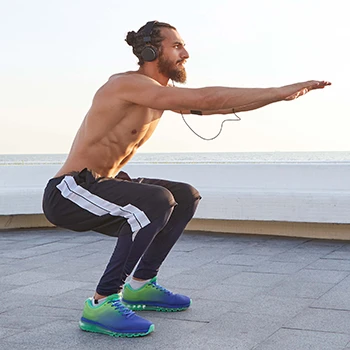
You should squat with proper form because it is essential to engage muscles effectively and prevent injuries that can hinder your progress.
I've learned from training and client experiences that bad squat form often causes knee and back injuries, setting you back for months and messing up other exercises like deadlifts.
So, I'm all about nailing the right squat technique.
With injuries, you’re highly likely to miss out on heavy workouts that can further your progress.
Also, warming up before squatting is a must. A solid warmup boosts muscle temperature and blood flow, improving your performance and lowering injury risk, says the Journal of Exercise Rehabilitation [11].
“Learning how to squat correctly is important for many movements you perform during everyday life, as well as for just about any type of sport.”
- Dr. Matthew T. Boes, MD, Orthopedic Surgeon
6 Variations for Beginners

Over my decade of fitness training, I've introduced many beginners to various squat variations from different cultures.
Each variation offers unique benefits for building a strong core and lower body, including a positive impact on testosterone levels.
These compound squat exercises target multiple muscle groups. Here's our list of the top squat variations, from toughest to simplest. You'll need a squat rack for the first three.
1. High Barbell Back Squat
To perform the high barbell squat:
- Load the barbell safely on your back and shoulders. Stand with your feet shoulder-width apart, with your toes pointing outward.
- Brace your core, and keep your chest up. Take a deep breath through your mouth.
- While holding your breath, lower yourself by initiating the squat movement. You can either squat until your thighs are parallel to the floor or go as deep as possible.
- Push through with your whole body, and return to the starting position.
2. Low Bar Back Squat
It's like the high barbell squat but with feet wider than shoulder width and the barbell just below the traps.
You can lift more weight with this squat.
3. Front Squat
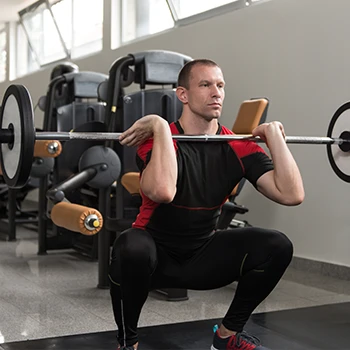
Note that it requires flexible wrists. Use wrist straps if needed, especially for front squats.
To perform a front squat:
- Stand facing the barbell on the squat rack, and position it so it rests in front of your shoulders. Keep it stable by holding it with your fingers under the barbell.
- Keep your feet shoulder-width apart and your toes slightly outward.
- Follow steps 3 and 4 of the high barbell back squat.
4. Deep Squat
To perform a deep squat:
- Do a regular bodyweight squat. But instead of stopping when your thighs are parallel to the floor, go as low as possible while maintaining a straight back.
- Once you reach the bottom, pause and explode up.
- You may add weight by holding a dumbbell or kettlebell.
You can also incorporate a jump when exploding up to make this a plyometric exercise, but beware of the additional weight, as it may cause injury upon landing.
5. Prisoner Squat
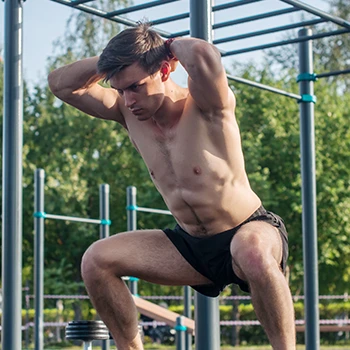
To perform the prisoner squat:
- Stand with your legs placed a little less than shoulder-width apart. Place both your arms behind your head (with your palms touching the back of your head).
- Pull back your elbows and keep your chest lifted.
- Lower yourself down to a parallel or full squat.
- Straighten up and repeat.
6. Bodyweight Squats
If any of these are difficult, you can simply start off with bodyweight squats. To perform these:
- Keep your feet shoulder-width apart.
- Squat down by bending your knees, keeping your arms in front of you, and keeping your back straight.
- Once your thighs are parallel to the floor, come up.
- Repeat until you’re ready to add weights.
“Performing body weight squats daily can help to maintain your body's tolerance to daily activities. Strengthening the back muscles is ultimately the best way to prevent back injuries when lifting and carrying heavier objects.”
- Dr. Tim Schuckers, PT, DPT, OCS
Some Precautions

While squats are a super effective exercise, it’s easy to mess them up and injure yourself. So, here are some precautions to keep you squatting regularly and effectively:
- Use proper form: Using proper form is key to preventing injuries and making the best of your compound lifts.
- Get enough rest and recovery: Squats demand a high level of mental and physical exertion, especially when you perform heavy squats. And I’ve seen too many squat injuries that result from over-exertion and lack of rest.
- Eat well: Eat only foods rich in protein to gain muscle and help your muscles recover. While lifting light with sore muscles is okay, don’t lift heavy reps on rest days.
- Take the right supplements: If you want to see a significant increase in testosterone naturally, we highly recommend taking natural testosterone boosters to enhance your performance with your resistance exercises.
FAQs
Should I Add Squats to My Lifts Even if I’m Doing Other Leg Exercises?
Yes, you should add squats to your lifts even if you’re doing other leg exercises. Squats demand a high level of leg-muscle activation (in addition to other muscles). Adding squats to your weight training regimen will only have benefits unless you suffer from injuries.
How Frequently Should I Perform Squats to Increase Testosterone?
You should perform heavy squats at least once a week to increase testosterone. Experts assert that a rep scheme of 6 sets of 10 squats might be most effective in increasing post-exercise testosterone. However, this will also depend on how heavy you’re lifting and your current testosterone levels.
Can the Leg Press Increase Testosterone as Well as Squats?
No, the leg press cannot increase testosterone levels as well as squats because they don’t engage as many muscles as squats. Additionally, different variations of the squat may affect your post-testosterone levels differently based on the muscles they engage.
Why Haven’t My Testosterone Levels Risen After Squatting Regularly?
Your testosterone levels haven’t risen after squatting regularly, probably because you may not be recovering well, among a host of other reasons. Another reason is that you may not be doing your squats using a proper form; this affects how many muscle groups you engage and, by extension, your post-workout testosterone levels.
References:
- https://pubmed.ncbi.nlm.nih.gov/30531700/
- https://www.thieme-connect.de/products/ejournals/abstract/10.1055/s-2007-1024673
- https://journals.lww.com/nsca-scj/fulltext/2014/12000/the_back_squat__a_proposed_assessment_of.2.aspx
- https://www.health.harvard.edu/diseases-and-conditions/growth-hormone-athletic-performance-and-aging
- https://diabetesjournals.org/diabetes/article/41/4/424/7956/Growth-Hormone-Stimulates-Skeletal-Muscle-Protein
- https://physoc.onlinelibrary.wiley.com/doi/full/10.14814/phy2.12166
- https://www.sciencedirect.com/science/article/abs/pii/S1096637415000209
- https://www.ncbi.nlm.nih.gov/pmc/articles/PMC6006542/
- https://www.health.harvard.edu/diet-and-weight-loss/calories-burned-in-30-minutes-for-people-of-three-different-weights
- https://www.acefitness.org/resources/everyone/blog/
- https://e-jer.org/journal/view.php?number=2013600467
About The Author
You May Also Like

